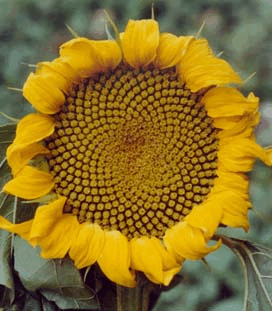Sunflower Season Will Soon Be Upon Us
Sunflowers (Helianthus annuus) are a beautiful and fascinating plant. A sunflower is actually a flower head composed of 1000-2000 individual florets which mature into seeds. The beauty of the sunflower is directly tied to its geometric regularity and the opposing spirals of florets and seeds. Each floret is oriented 137.5 degrees to its adjacent floret; this pattern is based on a mathematical series known as Fibonacci numbers, and on the Golden Mean. Do some reading on these terms — their history and uses are fascinating. The pattern observed on sunflowers is the most efficient for packing seeds in a flower head.
Sunflower seeds are edible by humans, birds, livestock, and provide oil; the fiber in the plant stalks can be used in papermaking. The US Department of Agriculture estimates that in 2011, 1.5 million acres of sunflowers were harvested nationally (this area is 16% larger than the state of Delaware and twice the size of Rhode Island), yielding 2.04 billion pounds valued at $603.6 million.
The strength of sunflower production in the US may be due in part to Patent Number 4,254,580, issued on March 10, 1981. David B. Ferguson of Fresno, CA developed an invention for “Production of sunflower seeds in increased yields,” which was assigned to David & Sons, Inc., also of Fresno. The USPTO considers the invention to be one of multicellular living organisms and unmodified parts thereof and related processes, and more specifically, a method of using a plant or plant part in a breeding process which includes a step of sexual hybridization, and most specifically, a method of breeding involving a genotypic or phenotypic marker. You will find these inventions in classification 800/266.
Ferguson’s Claim 1 says:
“1. A process for the production of sunflower seeds in increased yields comprising:
(a) planting in a growing area a plurality of seeds capable of forming Helianthus annuus sunflower plants which are physiologically self-compatible and possess homozygous f genes, said planting being carried out in the substantial absence of seeds capable of forming Helianthus annuus sunflower plants which are physiologically self-incompatible and/or lack homozygous f genes, whereby said seeds germinate to form sunflower plants, and seeds are formed on said sunflower plants as a result of self-pollination, said f genes having the ability to facilitate the formation of parenchyma cells between floret anthers which allow the anthers to become substantially non-fused following pollen dehiscence thereby making possible a greater degree of self-pollination with concomitant increased seed formation, and
(b) harvesting said resulting seeds formed on said sunflower plants.”
Translating, the invention provides a novel and highly effective technique for enhancing the production of sunflower seeds via an agricultural process wherein a greater proportion of the florets which make up the sunflower are effectively pollinated.
Found in the patentECO Agriculture Index, along with other yield enhancement innovations, you can remember Ferguson’s contribution to you snack of sunflower seeds.
